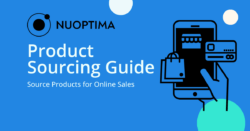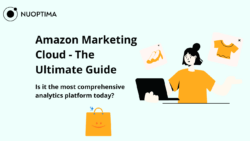Ah, the bustling world of Amazon – a treasure trove for sellers and a paradise for buyers. As you’re reading this, you’re probably aware that while the marketplace offers immense opportunities, it’s equally packed with fierce competition. This is where Amazon PPC (Pay-Per-Click) advertising comes into play.
Now, why should you bother with ads? In simple terms, it’s a surefire way to increase the visibility of your products, build brand awareness, and, ultimately, amplify sales. Whether you’re a fledgling seller just starting or a seasoned pro aiming to diversify your promotional efforts, understanding Amazon PPC best practices can be a game-changing manoeuvre in your e-commerce strategy.
So, if you’re keen on cracking the code to Amazon PPC optimisation, you’re in the right place! From setting explicit objectives to mastering budgeting and bidding, this guide has been put together by the gurus at our Amazon PPC agency so you have actionable tips and tricks that will steer you through the labyrinth of advertising. Ready to dive in? Let’s get cracking!
9 Amazon PPC Best Practices You Don’t Want to Ignore
Alright, let’s delve into the nitty-gritty. Amazon PPC best practices aren’t just a collection of wise tales passed down from e-commerce gurus. These proven methods can get your products front and centre, from capturing clicks to converting these into cold, hard sales. This section unpacks these prime methods, exploring everything from setting robust goals to leveraging advanced optimisation techniques. Ready for some heavy lifting? Here we go!
1. Setting Clear Objectives
First things first, you can only hit a target if you know what you’re aiming for. Establishing well-defined, measurable objectives for your campaigns is paramount. Why? Because these goals serve as the compass that guides every subsequent decision you’ll make, from keyword selection to budgeting.
For example, if your goal is to increase sales, your strategies should focus on high-converting keywords and competitive bidding. Conversely, if you’re more about building brand awareness, you might concentrate on broader search terms that garner a high volume of impressions.
Let’s explore some common ad objectives:
- Increasing Sales: If revenue growth is your prime objective, you’d likely want to focus on keywords and ad placements that have historically led to conversions. It’s not just about getting eyes on your product; it’s about getting clicks that convert.
- Brand Awareness: Suppose you’re a new player in the market or launching a novel product. In that case, visibility might be your first goal. Leveraging PPC allows your product to be seen by a vast audience, setting the groundwork for future sales.
- Launching a New Product: When introducing something new to the marketplace, your objectives might include driving initial reviews and climbing the organic rankings. These ads can expedite this process, helping your product gain the traction it needs.
Remember, a one-size-fits-all approach won’t cut it in Amazon’s dynamic ecosystem. Tailor your objectives to your specific business and campaign needs for maximum efficacy.
Your brief checklist could look like this:
- Define your primary goal (sales, brand awareness, review scale).
- Select keywords that align with your goal.
- Develop a budget based on expected performance metrics.
- Evaluate the results and adjust your strategy accordingly.
2. Choosing the Best Ad Type for Your Business
So you’ve got your goals neatly laid out – fantastic! However, before you dive in, it’s crucial to pick the right vehicle to carry your advertising message. Each type of ad serves a specific purpose, and understanding these can be a game-changer in how effectively you reach your goals. Let’s take a deeper look.
Sponsored Products
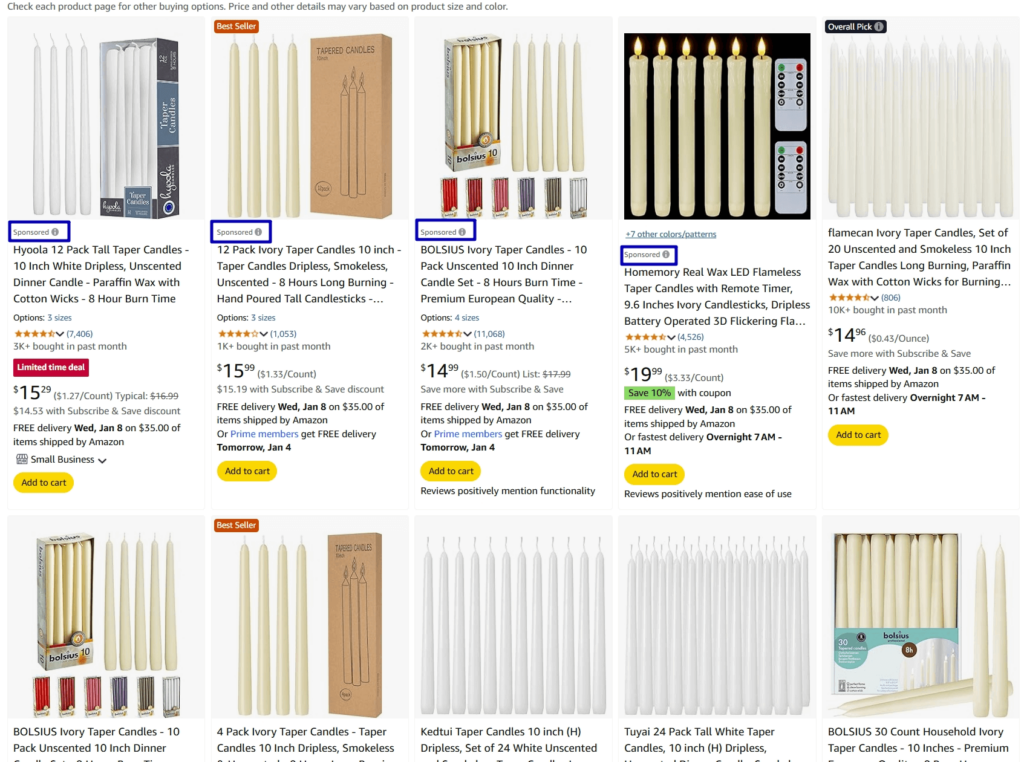
If you’re keen to influence the sales of specific items in your catalogue directly, Sponsored Products are your best friend. These ads are seamlessly integrated into search results and product pages, creating a natural shopping experience for consumers. Imagine a customer searching for ‘waterproof hiking boots’. If that’s a product you offer, this type of ad can catapult your boots to the first page of search results, immediately catching the eye of a potential buyer. This ad works exceptionally well for both new launches and existing products. Plus, since you only pay for clicks, you’re spending money solely to heighten your sales prospects.
Sponsored Brands
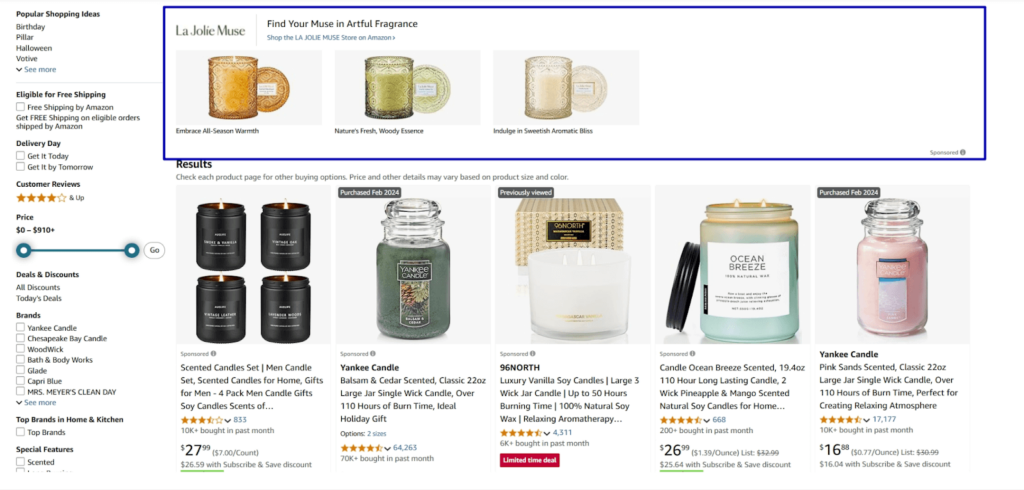
For sellers with a broader range of products or those focused on elevating their brand profile, Sponsored Brands provide an incredible advantage. Here, it’s not just about an isolated product but about telling a brand story. Imagine this: a shopper types in ‘organic skincare’, and right at the top, they see your brand name, an enticing image, a catchy headline, and a few of your top-selling creams and lotions. It’s a multi-product approach that immediately positions you as a prominent player in the sector. Utilising Sponsored Brands could be a pivotal strategy when expanding your product line or entering a new market segment.
Sponsored Display
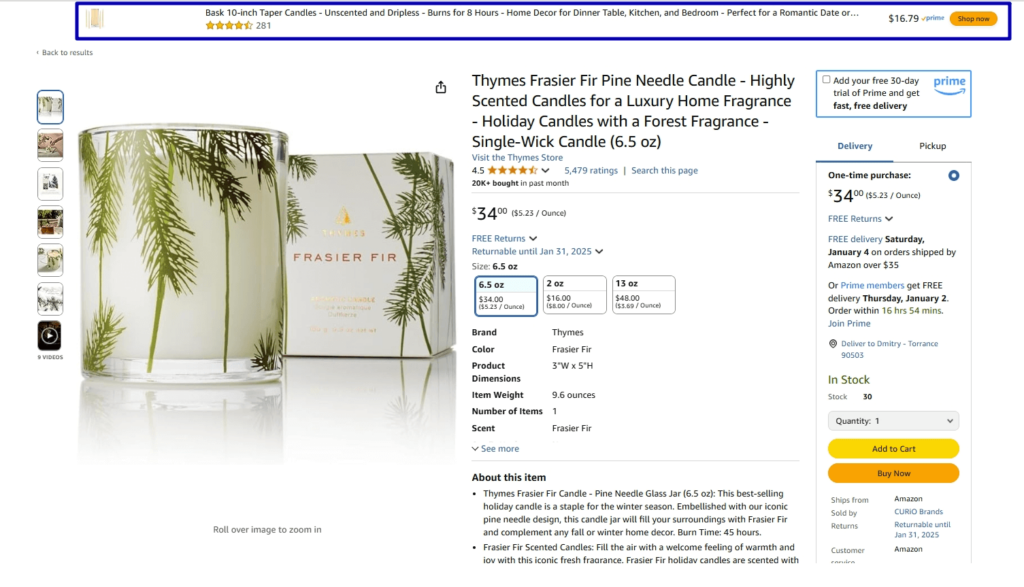
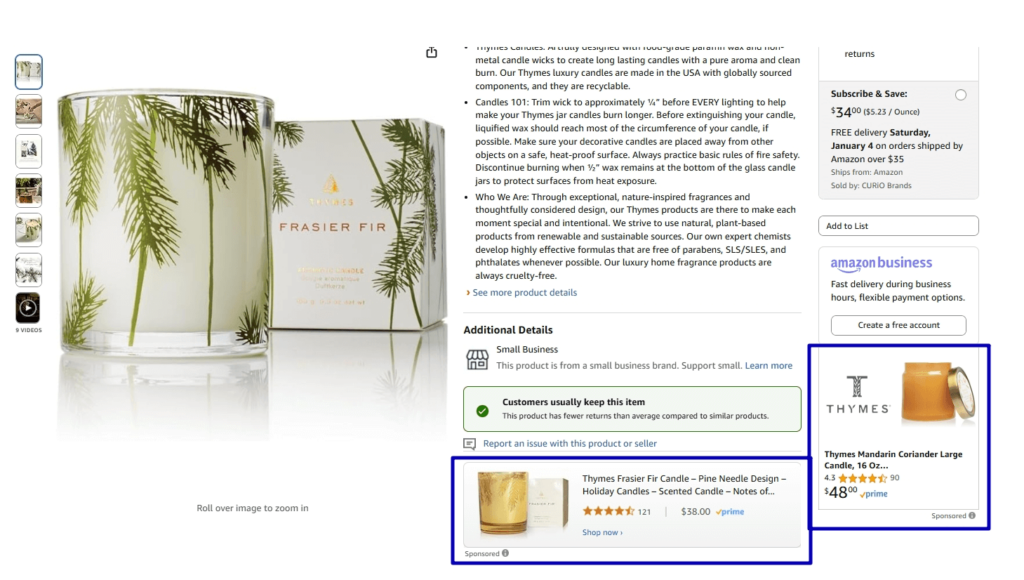
Now, let’s say you’re looking to retarget potential customers who’ve shown interest in products similar to yours but have yet to make a purchase. Sponsored Display ads do this brilliantly by appearing not just on Amazon but also on external websites and apps. Think of it as a gentle nudge to remind customers, ‘Hey, remember that camera lens you checked out? It’s still here, and it’s awesome’. This ad type is an excellent tool for businesses that are ready to expand their marketing beyond the platform.
DSP (Demand-Side Platform)
For those willing to invest in more complex, highly targeted advertising, the DSP offers a goldmine of opportunities. You could create tailored campaigns that segment audiences based on shopping behaviour, geographic location, and even the devices they use. The breadth of ad formats here – from display to video and audio – means you can engage your audience in multiple, creative ways. If you’ve got a substantial budget and big plans, the DSP allows you to experiment and hone your promotion to a fine point.
TV Ads
Last but by no means least, if you want to take your promotional efforts into the realm of live TV, we’ve got you covered. Amazon TV ads are an extravagant but impactful way of capturing a broad audience’s attention. Picture your brand’s advertisement streaming between popular shows on Fire TV or IMDb TV. This is big-scale visibility, and if done right, it can elevate your brand awareness to new heights.
Understanding Ad Auction Mechanism
So, how does Amazon decide which ads get the limelight? It’s all about their ad auction mechanism. When a user enters a search query, the algorithm looks at your ad’s relevance and how much you’re willing to bid for that placement. This isn’t a straightforward highest-bid-wins scenario. For instance, if your hiking boots are spot-on and relevant to the search query, but you bid slightly less than a competitor selling, say, hiking accessories, your ad could still take the prime spot. It’s a nuanced balance of bid amount and relevance that makes mastering Amazon PPC optimisation so vital.
Summary Table: Choosing the Best Ad Type for Your Business
| Ad Type | Description | Best Suited For |
| Sponsored Products | Appear in search results and on product pages | Sellers looking to promote individual listings and drive immediate sales, getting high visibility on product search pages |
| Sponsored Brands | Banner ads at the top, middle, or bottom of search results | Brands wishing to increase recognition and visibility, directing traffic to custom landing page or store |
| Sponsored Display | Ads displayed on product detail pages, related products, and elsewhere both on and off Amazon | Sellers wanting to retarget shoppers or expand reach |
| DSP (Demand-Side Platform) | Programmatic display or video ads across the internet | Advertisers looking for advanced targeting and mass reach across multiple platforms, including Amazon and other publishers |
| TV Ads | Video ads on streaming services, potentially traditional TV networks | Major brands aiming for large-scale awareness |
3. Structuring Amazon Campaigns
With your objectives clear and your ad type picked, you’re revving to go. But before you hit the throttle, let’s talk about something often glossed over but fundamentally essential: structure. It’s akin to laying down the foundation before building a house. A well-structured campaign not only makes it easier to manage and scale your advertising but also helps in efficient budget allocation and better performance tracking. A disorganised campaign is like a ship without a compass – you might move, but you’ll likely drift off course.
The Importance of Consistency
Imagine searching for a lost item in a room where everything is randomly strewn around. Frustrating, isn’t it? The same applies to your PPC campaigns. If your campaigns are all over the place, good luck finding which keywords are performing well or why a particular ad set is underperforming. Consistency is not just a best practice; it’s a necessity. It facilitates easy navigation, enhances understanding, and, most importantly, simplifies the intricate optimisation process.
Laying Down the Structure
So, how should you go about it? Here’s a simplified guide to structuring your ad campaign:
- Campaign Level: At the top of the hierarchy, you should have different campaigns for distinct objectives. For example, one for increasing sales of your bestselling items, another for launching a new line of products, and perhaps a third for targeting a specific season or holiday.
- Ad Group Level: Within each campaign, organise your ads into groups based on similarities like product features or target audiences. Let’s say you have a campaign focused on kitchenware. One ad group could feature non-stick pans, another might highlight your range of ceramic plates, and a third could focus on utensils.
-
Product and Keyword Level: Inside each ad group, list the specific products you’re advertising and associate them with relevant keywords. For your non-stick pan ad group, for instance, you could have keywords like ‘best non-stick frying pan’, ‘durable non-stick pans’, and ‘non-stick skillet’.
Ad Group 1: Non-stick frying pans.
Keywords: “best non-stick frying pan,” “durable non-stick pans.”
Negative Keywords: “cheap,” “budget.”
Ad Group 2: Ceramic plates.
Keywords: “ceramic plate set,” “modern plates.” -
Negative Keywords: For each ad group, it’s also a good idea to have a list of negative keywords – words that you don’t want triggering your ads. For example, if you’re selling premium, high-cost kitchenware, you might include ‘cheap’ or ‘budget’ as negative keywords.
To check yourself, ask and answer the following questions:- Do all the keywords align with the campaign objectives?
- Are negative keywords identified to exclude irrelevant queries?
- Are bidding strategies clearly defined?
-
Bid Strategy: And don’t forget your bid strategy. Within each ad group, determine your keyword bids. Are you going for manual or automated bidding? What’s your budget allocation like for high-performing keywords versus low-performing ones?
After launching the campaign, regularly monitor its performance. Use analytics to adjust bids, optimize keywords, and add new negative keywords.
The Elements of an Effective Campaign Structure
A structurally sound campaign isn’t just about neat folders and labels. Each element – from your campaign objective to individual search terms – needs to be meticulously planned and placed. Here are some core elements to consider:
- Budget: This serves as your campaign’s financial backbone. Set it too low, and you miss opportunities; set it too high, and you risk overspending.
- Keywords: These are the building blocks of your campaign. Choosing the right ones can make all the difference in how effectively you reach your target audience.
- Ad Content: This is where the magic happens. Your ad copy and visuals must be compelling enough to convince shoppers to click and make a purchase.
- Performance Metrics: Establish the key performance indicators (KPIs) you’ll use to measure success, like Advertising Cost of Sales (ACoS), TACoS, and conversion rates. Knowing your metrics makes optimisation simpler and more strategic.
- Scheduling: Timing can be everything. Knowing when your audience is most active can influence your bid procedure and, subsequently, your campaign’s success.
By following a robust and consistent structure, you’re setting the stage for Amazon PPC optimisation that’s manageable and effective. You’ll find yourself less overwhelmed and more in control, ready to make data-driven decisions that lead to tangible results.
4. Keyword Research and Selection
Picture this: You’ve crafted a stellar ad that ticks all the boxes – appealing visuals, persuasive copy, and a budget allocation that would make even a seasoned financial planner nod in approval. But if you haven’t chosen the right search terms to trigger that ad, you might as well be shouting in a void. This is where keyword research, the lifeblood of any campaign, comes into play. With the right keywords, your ad not only reaches the people you intend but also maximises the bang for your buck. Let’s delve into how you can make that happen.
The Toolbox: Essential Tools for Keyword Research
The first question that probably arises is, ‘Where do I even find these magical terms’? There are plenty of tools designed to take the guesswork out of this task. Software like MerchantWords, Helium 10, or even Amazon’s own Keyword Planner can offer insights into what shoppers are searching for, along with data on keyword competition and potential return on investment (ROI).
But don’t just rely on tools. Tap into your intuition and understanding of your product and target audience. What would you search for if you were looking for your product? Start by brainstorming with team members or even friends and family to create an initial list.
Fine-Tuning: Broad, Phrase, and Exact Match Keywords
Once you have a preliminary list of keywords, it’s time to get into the finer points – specifically, the kind of match types you want to use for these keywords.
- Broad Match: This is your wide net, capturing any searches that include your keyword in any order, along with related terms. If your keyword is ‘organic dog food,’ a broad match could trigger your ad for searches like ‘best dog food that is organic’ or even ‘healthy organic meals for dogs’.
- Phrase Match: A bit more restricted, phrase match keywords will trigger your ad if the search contains your keyword in the exact sequence, albeit with extra words before or after it. So, ‘organic dog food’ could trigger the ad for ‘best organic dog food’ but not for ‘best dog food that is organic.’
- Exact Match: This is the sniper rifle in your keyword arsenal. Your ad will only appear if the customer types in the precise term, no more, no less. Exact match keywords are ideal for highly competitive terms where you want to minimise wasted spend.
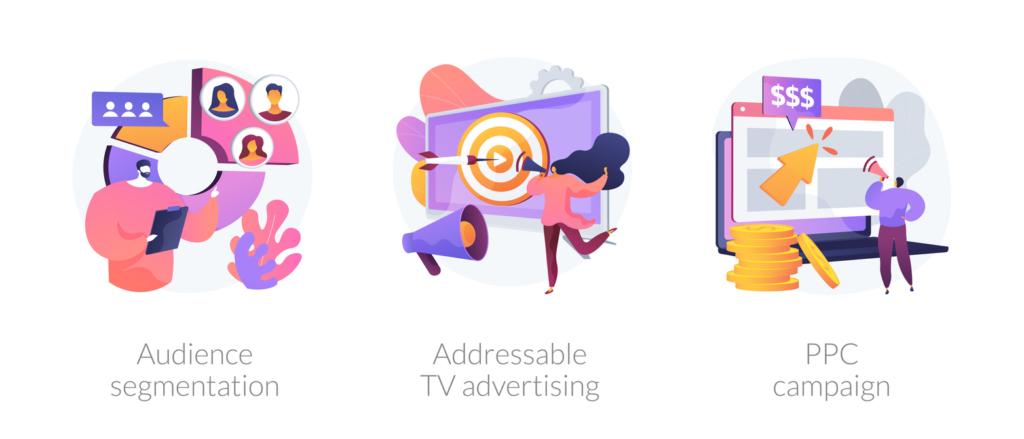
5. Budgeting and Bidding Strategies
The engines are humming, your compass is set, and your map has all the hotspots clearly marked. But to keep this metaphorical ship of an Amazon PPC campaign sailing smoothly, you need fuel – that’s your budget – and a good set of hands at the wheel, guiding where that fuel goes – your bidding methods. With the right blend of the two, you’re not just moving but cruising in style on a route meticulously designed for success. Let’s explore how to go about it, shall we?
Budget: The Fuel for Your Campaign
Setting an optimal budget for your campaign is a critical, yet often tricky, balance to maintain. Too low, and you’re essentially sidelining yourself, missing out on valuable visibility and sales opportunities. Too high, and you could be hurtling towards financial inefficiency. So, how do you set it ‘just right’?
Start by considering your objectives. If your primary goal is to accelerate sales for a high-margin product, a more generous budget may be warranted. Likewise, if you’re targeting highly competitive keywords, you’ll need deeper pockets to stay in the game. Whatever your situation, always keep an eye on metrics like ACoS to ensure that your spending translates into profitable outcomes.
Manual vs Automatic Bidding: Choose Your Captain
Once the budget is sorted, the next big decision is how to manage your bids. Amazon provides two overarching options:
- Manual Bidding: If you love getting down to the nitty-gritty and have the data to make informed decisions, manual bidding offers the control you crave. You set the bids for each keyword or ad group, allowing for precise optimisation. This is great for experienced sellers who know the landscape well.
- Automatic Bidding: Prefer to let the algorithms do the heavy lifting? In the automatic bidding model, your bids are dynamically adjusted in real-time, with the goal of maximising either clicks or conversions within your predetermined budget. This is particularly helpful for newcomers or those who prefer a hands-off approach or those looking to discover new keywords that can later be transitioned into a manual campaign.
Advanced Moves: Dynamic Bidding and Bid Adjustments
Now that you’ve picked your process, let’s add some finesse to your bidding game with some Amazon PPC best practices.
- Dynamic Bidding: This is a feature available in manual bidding where Amazon adjusts your bid within a range, up or down, depending on the likelihood of a conversion. This tactic is particularly useful when you have fluctuating performance across different times or audience segments.
- Adjusting Bids by Placement: This strategy allows you to set a percentage increase for your bids when your ads appear in high-visibility placements, like the top of the first search page. If you have a killer product listing and high confidence in your offering, bumping up your bid for these prime spots can drive significant ROI.

To truly optimise Amazon ads, consider leveraging these advanced tactics based on the performance data you gather over time. Whether it’s reducing bids for underperforming keywords or funnelling more budget into your winners, always be ready to pivot and adapt.
6. Optimising Product Listings
You’ve got your budget, bidding strategies, and keywords all neatly tied up. But let’s be frank: without a magnetic product listing, all the Amazon PPC optimisation in the world won’t save you. Think of it this way: your ads are the headline act, but your product listings are the grand stage they perform on. And let’s face it, even a rockstar sounds mediocre on a dodgy stage.
Why High-Quality Listings Are Non-Negotiable
High-quality product listings don’t just enhance your brand image; they dramatically amplify the performance of your PPC campaigns. Why? Well, a user clicking on your ad expects continuity. They’ve seen something in your ad that piqued their interest; now they’re landing on your listing to delve deeper. A subpar listing breaks that narrative, leaving you with a higher bounce rate and a wasted ad click.
The Building Blocks of a Stellar Listing
If your product listings are your stage, then high-quality images, compelling titles, and detailed product descriptions are the set designers, costume makers, and scriptwriters. Each element plays an irreplaceable role in the grand production. Let’s break it down:
- High-Quality Images: Humans are visual creatures. Blurry or poorly lit images don’t just make your product look bad; they reflect poorly on your brand. Invest in professional photography that showcases your product from multiple angles and settings. Also, make use of the zoom feature to display intricate details and consider getting creative with infographics.
- Compelling Titles: Ah, the first impression. Your product title must be an attention-grabbing yet succinct summary of your offer. Utilise the character limit wisely; include vital attributes like brand name, product type, size, and unique features. Additionally, always have relevant keywords.
- Detailed Product Descriptions: This is your chance to woo your audience with the finer details. An exceptional description not only details what the product is but also how it can solve a problem or enhance a life. Make it scannable with bullet points, and don’t shy away from including relevant keywords naturally.
-
Video: A Lively Presentation of Your Product: Video on your product page is a powerful tool for adding depth and engagement. It’s an excellent way to showcase how your product works in real life, its benefits, and features that may be hard to convey through images or text alone. Video helps ensure that buyers can “see” and “feel” the product before they purchase it. Videos can include:
- A demonstration of the product in action, such as its use or assembly.
- A comparison with competitors to highlight unique advantages.
- Stories from satisfied customers or testimonials to build trust.
- Quick tips and usage suggestions that can ease the purchase decision.
- Video helps capture the attention of buyers and can increase conversions, as consumers typically process information better through video. It also provides an additional SEO opportunity, as Amazon considers video as a ranking factor, improving your listing’s visibility.
- Including video in your listing is a great way to enhance brand perception, build trust, and convey the uniqueness of your offering.
The Cherry on Top: Amazon A+ Content
If you’ve been in the Amazon ecosystem for a while, you may remember services like Enhanced Brand Content (EBC). Well, times have changed. The marketplace has simplified things by combining EBC with A+ Content into a unified feature known simply as Amazon A+ Content. This new format gives you even more creative licence to elevate your product listings.
Now, instead of being boxed into specific formats, you can access various modules that let you stretch your creative muscles. Want to showcase your product from every angle? Use the 360-degree product views. Fancy allowing potential customers to compare two or more of your products side-by-side? The comparison module has got you covered. You’ll also be able to include additional text placements, enhanced images, and even videos in your listing. The merger of these features into A+ Content means you have a one-stop-shop to make your product listings as detailed and enticing as possible.
Stepping Up the Game With Amazon A++ Content
However, just when you thought the platform had peaked with its creative offering, enter A++ Content. Also known as Premium A+ Content, this feature is essentially the VIP lounge of Amazon listing optimisation. It’s an invite-only arena, predominantly offered to big players, luxury brands, and globally recognised tech products.
What makes it so special? Well, A++ offers even more customisation and control. Imagine embedding HD videos detailing your product’s features or including an interactive FAQ section on your listing page. It’s all about adding layers of sophistication to your brand story.
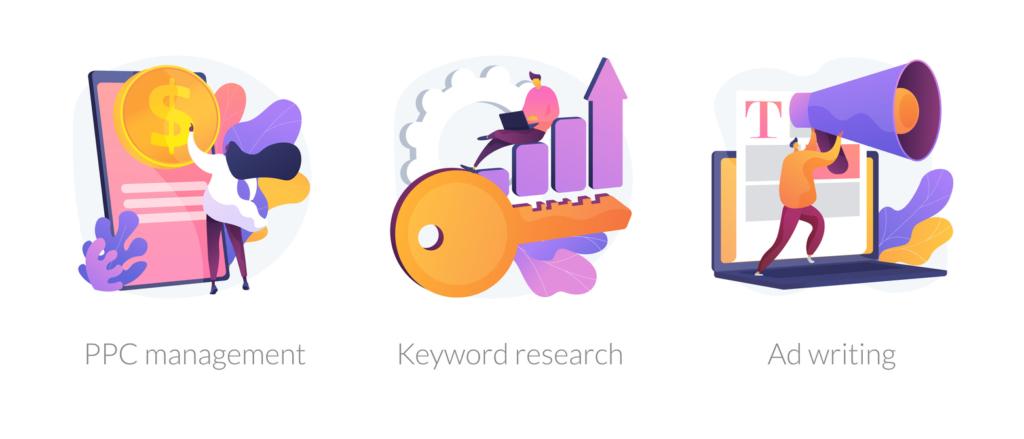
7. Leveraging Negative Keywords
Negative keywords are the unsung heroes of any stellar Amazon PPC guide. While you’re eager to shout your desired search terms from the rooftops, let’s not forget the power of whispering those alternative keywords in the algorithm’s ear. Think of it as your campaign’s bouncer, subtly nudging irrelevant traffic out the door so the VIPs – your target audience – can have a good time.
The Underestimated Role of Negative Keywords
So, what’s the big deal about negative terms? Well, they’re instrumental in refining your ad targeting. If you’re selling a ‘stainless steel coffee mug’, you don’t want to pop up in searches for a ‘plastic coffee mug’, do you? By specifying ‘plastic’, you keep your ad budget from draining on clicks that are highly unlikely to convert.
Best Practices for Identifying and Implementing Negative Keywords
Before you start tossing random terms into your campaign willy-nilly, let’s talk strategy – because, let’s be honest, random acts of optimisation rarely lead to success. Here are some best practices to get you started:
- Regular Reviews: Much like your main search terms, negative keywords aren’t a ‘set and forget’ component. Regularly reviewing your campaign metrics can shine a light on irrelevant or underperforming words.
- Broad and Exact Matches: Like your target terms, you can set negative keywords as broad, phrase, or exact matches. For instance, using the exact match ‘plastic coffee mug’ will ensure your ad doesn’t appear for that precise query. However, this won’t stop it from showing up for variations like ‘plastic mugs for coffee’.
- Use Search Term Reports: The Search Term Report in your Seller Central can be a goldmine for discovering unintentional matches. This report shows what actual search terms triggered your ads, allowing you to identify and weed out irrelevant queries.
- Seasonal Adjustments: Let’s say you’re selling woollen scarves. Adding ‘summer’ as a negative keyword during the warm months will help optimise your ad spend.
- Competitor Names: Unless you have a strong reason to target a competitor’s brand name, adding them as negative keywords can keep your campaigns focused on your unique value proposition.
In a nutshell, negative keywords are your protective shield in the grand scheme of Amazon PPC optimisation. They help maintain the relevance and efficiency of your ad campaigns, making sure you’re not throwing money down the drain on unqualified clicks.
8. Monitoring and Adjusting Campaigns
Alright, you’ve set up your campaign, sprinkled in your carefully researched search terms, and even deployed a slew of negative keywords to keep the riff-raff out. Job done, right? Oh, my friend, this is just the beginning. In the ever-changing marketplace, standing still is akin to going backwards. That’s why monitoring and tweaking your campaigns is paramount.
The Imperative of Regular Monitoring
Now, why do we keep harping on about monitoring? Simply put, what isn’t measured can’t be managed. The data you collect acts as the compass for your campaign’s future direction. If you’re not keeping tabs on how your campaigns are performing, you’re basically sailing blind in a sea of e-commerce. And let me tell you, it’s chock full of icebergs and choppy waters.
Metrics to Keep an Eye On
The key to Amazon PPC success lies in effective metric analysis. Don’t let the jargon scare you; these are just tools to help you measure performance. Here are a few you need to keep an eye on:
- ACoS (Advertising Cost of Sale): This one tells you the ratio of ad spend to sales. A lower ACoS is generally preferable, as you pay less to make a sale.
- TACoS (Total Advertising Cost of Sale): Consider this as ACoS’s more worldly cousin. It looks at your total sales, not just those generated through ads, giving you a more complete picture of how your advertising impacts your bottom line.
- Conversion Rates: This metric lets you know what percentage of clicks on your ad led to a sale. Higher conversion rates often indicate that your ad is not just attracting attention but compelling buyers to take action.
- CTR (Click-Through Rate): This metric shows the percentage of people who, after seeing your ad, clicked through to your product page. A high CTR may indicate that your ad caught attention and matches the expectations of your target audience. A low CTR may suggest the need to improve your creatives or targeting.
- CPC (Cost per Click): This is the average cost of a click on your ad. Understanding this metric is important for controlling expenses and optimizing bids. A high CPC may indicate that your bids are too high or that the competition is too intense.
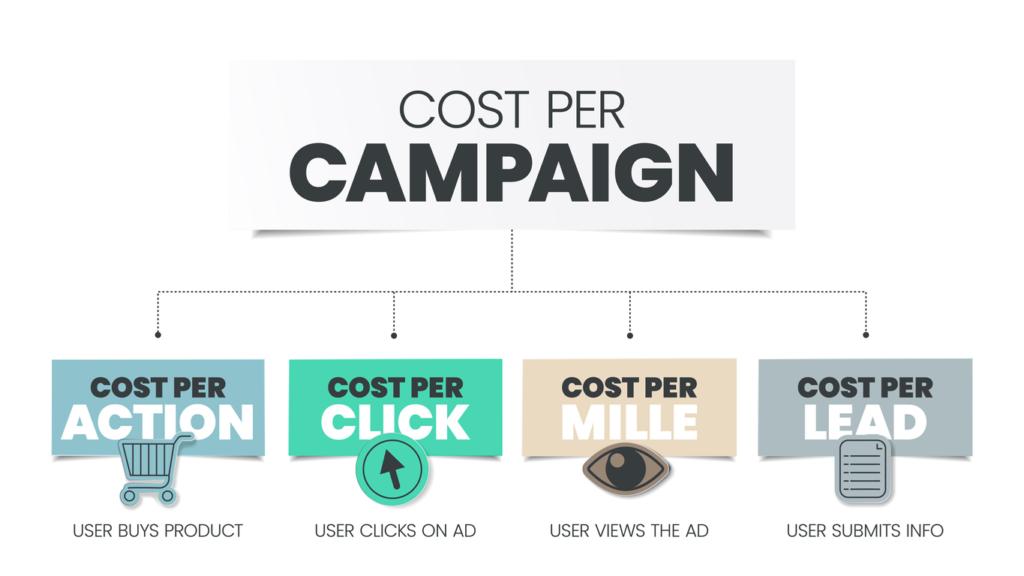
Handy Tips for Campaign Tuning
There are a few tactics you can follow when re-fining your campaigns. For example, you might try the following:
- Adjust Bids by Placement: If your ad performs well in top-of-search but not so well on product pages, consider upping your bid for those placements.
- Keyword Adjustments: Regularly review your Search Term Report to add or remove keywords based on their performance.
- Pause Low Performers: If a keyword or ad group isn’t delivering, don’t be afraid to pause it. It’s often better to focus on what’s working and optimise from there.
- A/B Testing: Experiment with different headlines, product descriptions, and images to see what resonates most with your target audience.
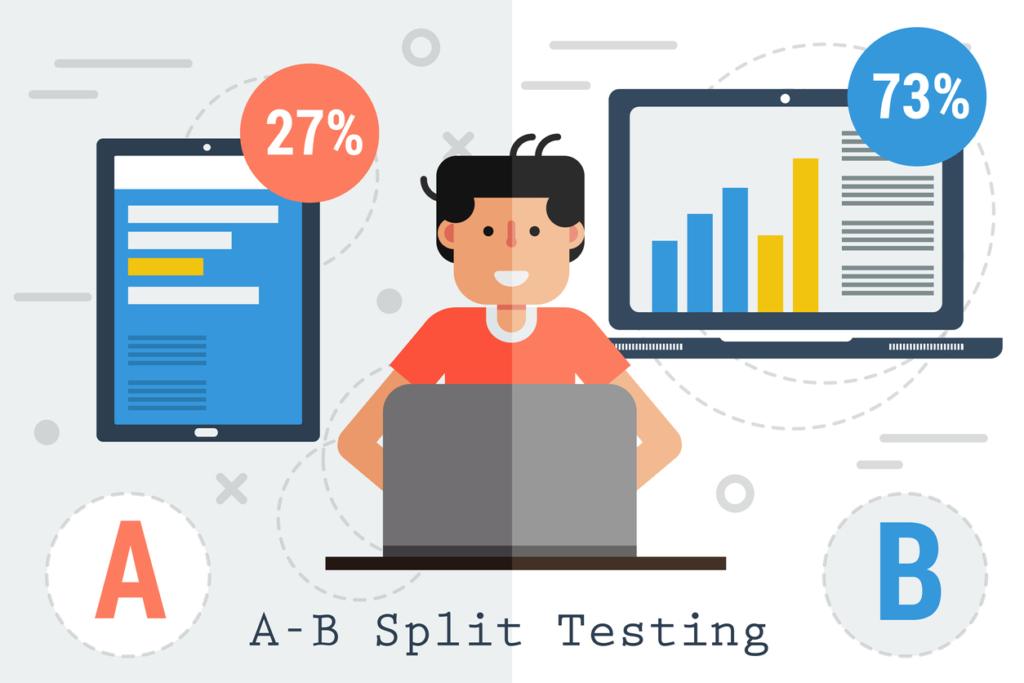
9. Exploring Advanced Strategies
So, you’ve got a handle on the basics – bravo! But let’s not rest on our laurels. The world of Amazon PPC is teeming with advanced strategies that can catapult your campaigns from ‘good’ to ‘outstanding.’ Are you up for the challenge? Then, let’s roll up those sleeves and explore the more sophisticated tactics that can turn you into a PPC maestro.
Dayparting: Timing is Everything
First up on our advanced list is ‘dayparting’. Now, don’t let the name intimidate you; this is simply the practice of adjusting your bids based on the time of day. Done well, dayparting can maximise your reach when your target audience is most active. Imagine knowing that your potential customers are night owls; you’d want your ads running full throttle from dusk till dawn. The reverse is also true; pull back your ads during low-traffic times to save those pennies.
Geo-Targeting: Location, Location, Location
The beauty of the internet is that it’s everywhere, but your customer might not be. With geo-targeting, you can channel your inner cartographer and specify where you want your ads to show up. Selling winter gear? Perhaps focus on colder regions. Got a product that’s all the rage in London but hasn’t caught on elsewhere? Well, you know where to direct your ad spend.
Segmenting Campaigns: One Size Doesn’t Fit All
Different products, seasons, or customer personas may demand unique approaches. Segmenting your campaigns allows you to tailor your messaging, keywords, and bidding approach to diverse target groups. Think of it as crafting personalised love letters for each audience segment. They’ll appreciate the extra effort, and your metrics will show it.
Optimising Ad Placements: The ‘Where’ Matters
Amazon offers a range of ad placements – from top-of-search to product pages to the ‘rest-of-search’. Now, here’s where you play the real estate mogul:
- Top-Of-Search: Prime online estate, but with a higher CPC. It’s worth it if you have a high-converting product.
- Product Pages: Great for newer or lesser-known brands to piggyback on the popularity of established products.
- Rest-of-Search: These ads appear at the bottom of search results. It’s cheaper but has less visibility. Consider using this space for products that are lower-cost but high-margin.
Analysing Successful Amazon PPC Campaigns
Well done for making it this far; you’re already ahead of the game! Now, theory is all well and good, but nothing speaks louder than actual results. In this next section, we’ll switch gears from the hypothetical to the real world by analysing successful Amazon PPC campaigns. We’ve even included screenshots so you can see what success looks like, pixel by pixel. Grab a cuppa, and let’s decode what makes these campaigns tick.
Amazon Ad #1
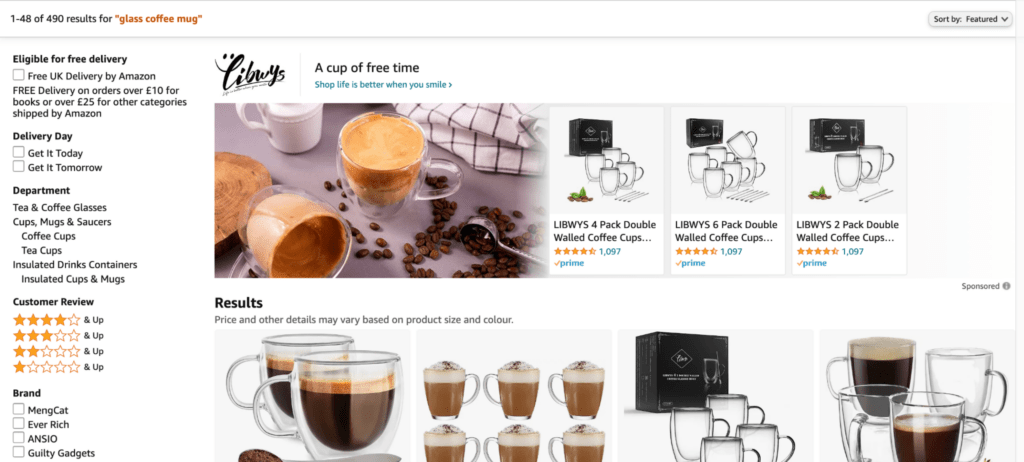
Keyword: Glass Coffee Mug
Good: Excellent imagery depicting the product. The ad is relevant and makes it clear what is on offer. Also, the products showcase a high number of great reviews.
Bad: The keyword isn’t clear in the text. This seller might benefit from including the keyword in the titles.
Amazon Ad #2

Keyword: Luxury Candles
Good: High-quality lifestyle image that gives a luxury feel to the brand. Additionally, Prime Delivery makes potential buyers feel more secure in their choice.
Bad: Only one product displays reviews, and it shows a small amount. Using a product with a higher number of reviews may improve the overall performance of this ad.
Amazon Ad #3
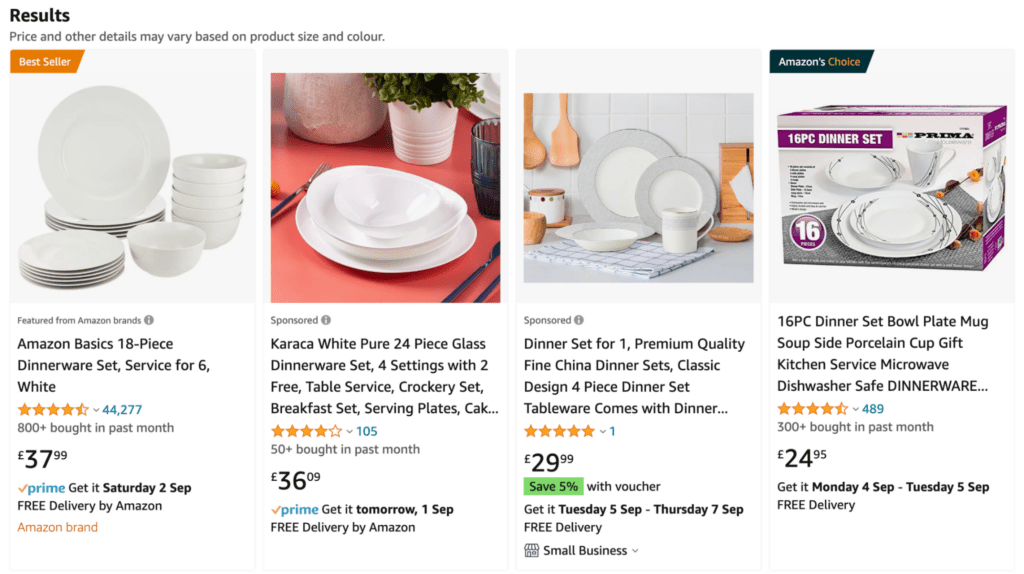
Keyword: Dinner Set
Good: The two ads that appear in this search (indicated by a ‘sponsored’ tag) both use high-quality lifestyle photos to make them more attractive. They are also priced competitively compared to the first result and use relevant search terms in the title.
Bad: Unfortunately, both lack substantial reviews. Specifically, the ad occupying the third position has just a single review, which may discourage prospective purchasers.
Amazon Ad #4
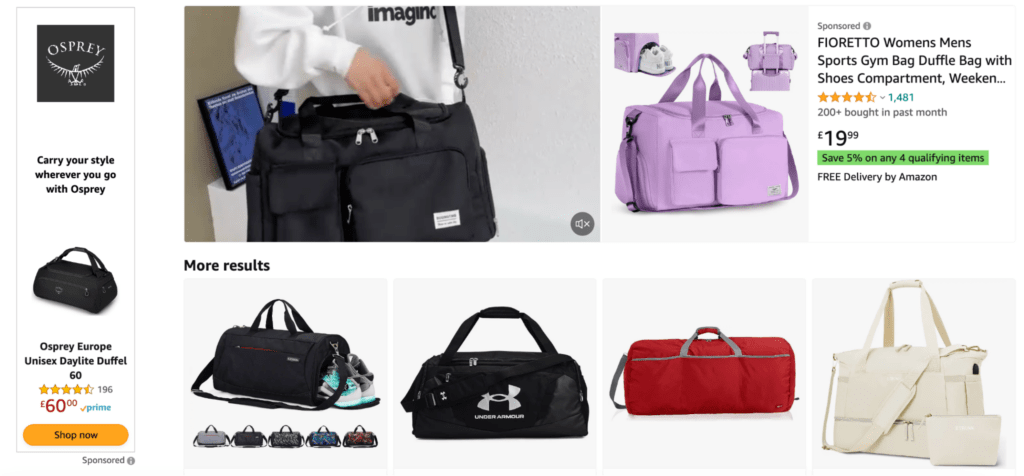
Keyword: Gym Bag
Good: There are two ads in this section of the results page; both are clear and relevant to the keyword. Although compared to the Sponsored Display ad on the left, the Sponsored Brand ad in the centre of the page may attract more attention because it features a dynamic video and high-quality imagery. In addition, it highlights the special feature of having a shoe department.
Bad: The ad on the left may see better results if they priced the product more competitively or highlighted an excellent feature. That said, they offer Prime Delivery, which stands out next to the adjacent listings. Moreover, the seller might consider including the keyword in the ad.
Amazon Ad #5
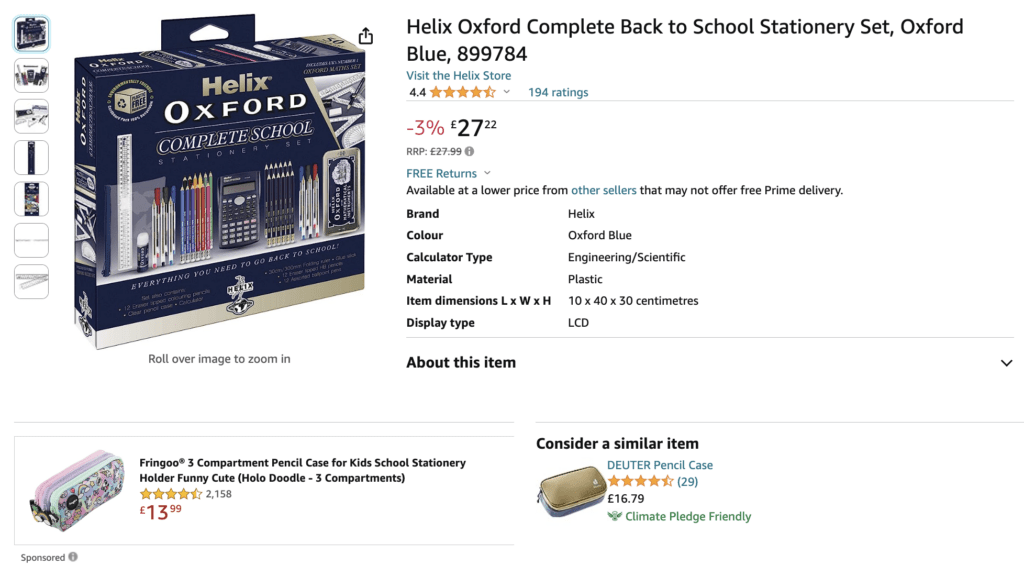
Keyword: Back to School Stationery
Good: This Sponsored Display ad appears below a relevant product listing. Rather than competing against the product, it shows the buyer a complimentary product. This is a great way to get your ad in front of a super-targeted audience. Additionally, the ad shows a plethora of positive reviews and highlights the unique feature of ‘3 compartments’.
Bad: Little room for improvement, though the seller may benefit from offering Prime Delivery.
Conclusion
Phew, we’ve covered a lot, haven’t we? From setting objectives and choosing the best ad type to diving deep into Amazon PPC best practices, we’ve journeyed through the labyrinthine landscape of advertising. But remember, the PPC world is ever-changing – static strategies are a thing of the past. To truly excel, you’ll need to keep learning, monitoring, and optimising.
If you need personalised guidance tailored to your unique business needs, book a call with our Amazon team today. Our PPC experts are always on hand to help you navigate your way to success, whether you’re grappling with PPC or need a full-stack Amazon management agency. Our Amazon agency provides tailored support no matter your goals.
FAQ
Success in Amazon ads isn’t a one-size-fits-all affair. It requires a blend of well-planned processes, from keyword research and budgeting to ad placement and continuous monitoring. Keep refining your approach based on performance data, and don’t be afraid to test new strategies.
The duration of your campaign largely depends on your goals and the products you’re selling. However, most experts recommend running campaigns for at least two weeks to a month to gather enough data for meaningful analysis and optimisation.
This varies from campaign to campaign and product to product. Generally, it can take several days to weeks to start seeing significant results. It’s crucial to monitor performance metrics like ACoS, TACoS, and conversion rates for a better understanding of your campaign’s effectiveness.
